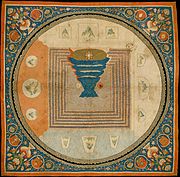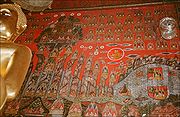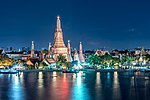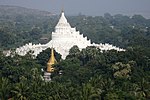Mount Meru
Mount Meru (
Many famous
Etymology
Etymologically, 'meru' in Sanskrit is borrowed from Dravidian 'mēl' or 'mēr' meaning 'high'. The proper name of the mountain is Meru (Sanskrit: Meruparvata), to which is added the approbatory prefix su-, resulting in the meaning "excellent Mount Meru" or "sublime Mount Meru".[3] Meru is also the name of the central bead in a mālā.[4]
In other languages
In other languages, Mount Meru is pronounced:
- Assamese: মেৰু পর্বত (Meru Pôrbôt)
- Bengali: মেরু পর্বত (Meru Porbot)
- Burmese: မြင်းမိုရ်တောင် ([mjɪ̰ɴ mò tàʊɰ̃])
- Cebuano: Bukid Meru
- Chinese: 須彌山 (Xūmíshān)
- Gujarati: મેરૂ પર્વત (Meru Parvat)
- Sanskrit, Marathi, Hindi: मेरु पर्वत (Meru Parvat)
- Ilocano: Bantay Meru
- Japanese: 須弥山 (Shumisen)[5]
- Javanese: ꦱꦼꦩꦺꦫꦸ (Semeru)
- Kannada: ಮೇರು ಪರ್ವತ (Meru Parvata)
- Khmer: ភ្នំព្រះសុមេរុ (Phnom Preah Someru) or (Phnom Preah Somae)
- Korean: 수미산 (Sumisan)
- Malayalam: മഹാമേരു പർവ്വതം (Mahameru Parvatham)
- Mongolian: Сүмбэр Уул (Sümber Uul)
- Nepali: सुमेरु पर्वत (Sumeru Parwat)
- Odia: ମେରୁ ପର୍ବତ (“Meru Pôrbôtô”)
- Old Maldivian: ސުމޭރު-މަންދަރަ "Sumēru-Mandara" (sometimes spelt as Ṣumeru-Mandara)
- Pāli: Sineru
- Punjabi: ਮੇਰੂ ਪਰਬਤ (Meru Parbat)
- Tagalog: Bulkang Meru
- Tamil: மகா மேரு மலை (Maha Meru Malai)
- Telugu: మేరు పర్వతం (Meru Parvatam)
- Sinhala: මහා මේරු පර්වතය (Maha Meru Parvathaya)
- Tibetan: ཪི་རྒྱལ་པོ་རི་རབ་
- Thai: เขาพระสุเมรุ (Khao phra sumen)
- Vietnamese: Núi Tu-di
Geography
The dimensions attributed to Mount Meru — which all refer to it as a part of the Cosmic Ocean, along with several other statements that describe it in geographically vague terms (e.g., "the Sun along with all the planets circle the mountain") — make the determination of its location most difficult, according to most scholars.[6][7]
Several researchers identify Mount Meru or Sumeru with the
The
- "Sumeruḥ Prithvī-madhye shrūyate drishyate na tu"
- (Sumeru is heard to be at the centre of the Earth, but is not seen there).[15]
Several versions of cosmology can be found in existing Hindu texts. In all of them, cosmologically, the Meru mountain was also described as being surrounded by Mandrachala Mountain to the east, Suparshva Mountain to the west, Kumuda Mountain to the north, and Kailasha to the south.[16]
In Buddhism
According to Buddhist cosmology, Mount Meru (or Sumeru) is at the centre of the world,
In
-
Yuan dynasty 1271–1368) Chinese mandala depicting Mount Meru as an inverted pyramid topped by a lotus.
-
Tibetan Buddhist embroidery representing Mount Sumeru.
-
The Mahabodhi Temple, a famous Buddhist temple at Bodhgaya, India, representing Mount Meru.
In Hinduism

Hindus believe Mount Meru to be a stairway to Svarga, a heaven where the devas reside.[23] Meru is considered as the center of the universe and is described as 84,000 yojanas high, about 1,082,000 km (672,000 mi), which would be 85 times the Earth's diameter. One yojana can be taken to mean about 11.5 km (9 miles), though its magnitude seems to differ over periods — for example, the Earth's circumference is 3,200 yojanas according to Varahamihira and slightly less so in the Aryabhatiya, but is said to be 5,026.5 yojanas in the Suryasiddhānta. The Matsya Purana and the Bhagavata Purana, along with some other Hindu texts, consistently give the height of 84,000 yojanas to Mount Meru, which translates into 672,000 miles or 1,082,000 kilometers. The Sun and Moon along with all the planets revolve around Mount Meru which connects the earth with the under world and heaven with Shiva residing on top of the mountain at Kailasha.[24][25] Gods and devas are described as frequenting Mount Meru.[26]
According to the
The Hindu epic Ramayana describes Kailash and Lake Manasarovar located in the Mount Meru as places unlike anywhere in the world.[24]
Vishnu Purana states that Meru is a pillar of the world, located at the heart of six mountain ranges symbolizing a lotus. It also states that the four faces of Mount Kailash are made of crystal, ruby, gold, and lapis lazuli.[23] It further talks about Shiva sitting in a lotus position, engaged in deep meditation within the confines of the mountain.[28] The mountain is home to four lakes, whose water is shared by the gods and four rivers that originate from the Ganges and flow to the earth. The Vayu Purana describes similarly with the mountain located close to a lake consisting of clear water with lotuses and lilies decked with water birds.[24] Bhagavata Purana places Kailash as located south of Mount Meru. Skanda Purana mentions that the mountain is located amongst the highest peaks, perpetually covered with snow.[24] Mount Meru was said to be the residence of King Padmaja Brahma in antiquity.[16]
This mythical mountain of gods was mentioned in the
In Jainism

According to Jain cosmology, Mount Meru (or Sumeru) is at the centre of the world surrounded by
Every Tirthankara is taken to the summit of Meru by Indra shortly after his birth, after putting the Tirthankara child's mother into a deep slumber. There, he is bathed and anointed with precious functions.[36][37] Indra and other Devas celebrate his birth.
Architecture
The concept of a holy mountain surrounded by various circles was incorporated into ancient Hindu temple architecture with a Shikhara (Śikhara) — a Sanskrit word translating literally to "peak" or "summit". Early examples of this style can be found at the Harshat Mata Temple and Harshnath Temple from the 8th century CE in Rajasthan, Western India. This concept also continued outside India, such as in Bali, where temples feature Meru towers.
In Buddhist temples, the Mahabodhi Temple in Bodh Gaya is the earliest example of the 5th- to 6th-century depiction. Many other Buddhist temples took on this form, such as the Wat Arun in Thailand and the Hsinbyume Pagoda in Myanmar.
-
The five central towers of Angkor Wat, before a Hindu and later a Buddhist temple in Siem Reap, Cambodia, symbolize the peaks of Mount Meru
-
Prang of Wat Chaiwatthanaram, a Buddhist temple in Ayutthaya, Thailand, representing Mount Meru
-
The meru ofParvathi
-
Depiction of Mount Meru at Jambudweep, a Jain temple in Uttar Pradesh
See also
Notes
- ^ Gopal, Madan (1990). K.S. Gautam (ed.). India through the ages. Publication Division, Ministry of Information and Broadcasting, Government of India. p. 78.
- ^ "THƯỢNG THẤT TIÊU TAI TẬP PHÚC DIỆU KINH". thegioivohinh.com. Retrieved 8 March 2023.
- )
- ^ "Meru". Sanskrit Dictionary. Retrieved 16 August 2019.
- ^ a b "Mount Sumeru". Nichiren Buddhism Library. Retrieved 17 August 2019.
- ISBN 978-0-415-24497-8.
- ^ "The Devi Bhagavatam". Sacred-texts.com. Book 8, Chapter 15. Retrieved 2 March 2012.
- ISBN 9781409488071.
- ^ Curzon, George Nathaniel (1968). The Hindu World: An encyclopedic survey of Hinduism. p. 184.
- ^ Walker, Benjamin (1969). Hinduism: Ancient Indian tradition & mythology. Purāṇas in Translation. p. 56.
- ^ Shastri, Jagdish Lal; Kunst, Arnold; Bhatt, G.P.; Tagare, Ganesh Vasudeo (1928). "Oriental literature". Journal of the K.R. Cama Oriental Institute: 38.
- ^ Rosenthal, Bernice Glatzer (1967). History: Geographical concepts in ancient India. p. 50.
- ^ Dube, Bechan (1972). India: Geographical data in the early Purāṇas: A critical study. p. 2.
- ^ Singh, M.R., Dr. (1971). India: Studies in the proto-history of India. p. 17.
{{cite book}}: CS1 maint: multiple names: authors list (link) - ^ cf. second verse of Koorma-chakra in the book Narpatijayacharyā
- ^ a b Mittal, J.P. History of Ancient India: From 7300 BC to 4250 BC. p. 3.
- ^ ISBN 978-1590301005.
- ^ Vasubandhu (1988–1990). Abhidharmakośabhāṣyam. Berkeley, California: Asian Humanities Press.
- ^ "The View from Mount Meru". Lions Roar. 20 August 2013. Retrieved 17 August 2019.
- ^ "What Is a Mandala?". studybuddhism.com.
- ^ "Preliminary practice (ngöndro) overview". September 2009. Retrieved 10 October 2016.
- ^ "Heruka Chakrasamvara". Khandro.net. Retrieved 2 March 2012.
- ^ ISBN 0-7088-2411-0.
- ^ ISBN 978-8-170-17336-6.
- ISBN 978-81-7625-039-9. Retrieved 6 September 2023.
- ISBN 978-8-187-96772-9.
- ^ "Mysteries of Kailash: What Are These 9-Foot Tall Entities Found In Mansarovar?". News24. 4 October 2023. Retrieved 1 December 2023.
- ISSN 0896-0801. 70696022.
- ISBN 979-413-290-X.
- ^ Cort 2010, p. 90.
- ISBN 978-0-19-538502-1
- ^ Schubring, Walther (1995), pp. 204–246
- ^ CIL, "Indian Cosmology Reflections in Religion and Metaphysics", Ignca.nic.in, archived from the original on 30 January 2012
- ^ Shah, Pravin K., Jain Geography (PDF), archived (PDF) from the original on 19 November 2002
- ^ Journal of the Asiatic Society of Bengal - Asiatic Society of Bengal, 1834
- ISBN 9780030061141.
- ^ "Jainism Literature Center - Rituals". Archived from the original on 16 August 2019. Retrieved 16 August 2019.
External links
- Description of Mount Meru in the Devi-bhagavata-purana 12
- Painting of Mount Meru found in Buddhist cave sanctuary in Xinjiang, China
- Mount Meru in Encyclopedia of Buddhist Iconography 12
- Ngari
- Tibetan Cosmological Models Archived 31 March 2018 at the Wayback Machine












